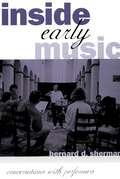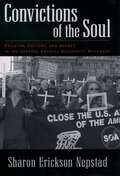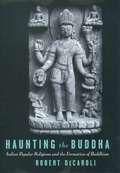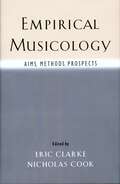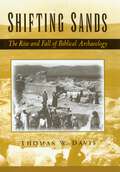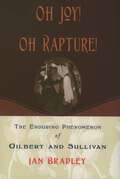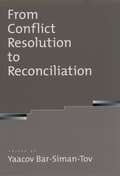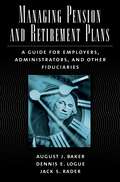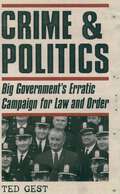- Table View
- List View
Inside Early Music: Conversations with Performers
by Bernard D. ShermanThe attempt to play music with the styles and instruments of its era--commonly referred to as the early music movement--has become immensely popular in recent years. For instance, Billboard's "Top Classical Albums" of 1993 and 1994 featured Anonymous 4, who sing medieval music, and the best-selling Beethoven recording of 1995 was a period-instruments symphony cycle led by John Eliot Gardiner, who is Deutsche Grammophon's top-selling living conductor. But the movement has generated as much controversy as it has best-selling records, not only about the merits of its results, but also about the validity of its approach. To what degree can we recreate long-lost performing styles? How important are historical period instruments for the performance of a piece? Why should musicians bother with historical information? Are they sacrificing art to scholarship? Now, in Inside Early Music, Bernard D. Sherman has invited many of the leading practitioners to speak out about their passion for early music--why they are attracted to this movement and how it shapes their work. Readers listen in on conversations with conductors Gardiner, William Christie, and Roger Norrington, Peter Phillips of the Tallis Scholars, vocalists Susan Hellauer of Anonymous 4, forte pianist Robert Levin, cellist Anner Bylsma, and many other leading artists. The book is divided into musical eras--Medieval, Renaissance, Baroque, and Classic and Romantic--with each interview focusing on particular composers or styles, touching on heated topics such as the debate over what is "authentic," the value of playing on period instruments, and how to interpret the composer's intentions. Whether debating how to perform Monteverdi's madrigals or comparing Andrew Lawrence-King's Renaissance harp playing to jazz, the performers convey not only a devotion to the spirit of period performance, but the joy of discovery as they struggle to bring the music most truthfully to life. Spurred on by Sherman's probing questions and immense knowledge of the subject, these conversations movingly document the aspirations, growing pains, and emerging maturity of the most exciting movement in contemporary classical performance, allowing each artist's personality and love for his or her craft to shine through. From medieval plainchant to Brahms' orchestral works, Inside Early Music takes readers-whether enthusiasts or detractors-behind the scenes to provide a masterful portrait of early music's controversies, challenges, and rewards.
Child Protection in America: Past, Present, and Future
by John E. MyersChild abuse and neglect are intractable problems exacting a terrible toll on children and rending the very fabric of our society. What can be done to reduce the suffering? If there were simple solutions to abuse and neglect they would have been discovered long ago. There are no easy answers, but in this vivid history of child protection in America, John E.B. Myers introduces realistic policies that will reduce maltreatment and strengthen the system that protects our children. Before it is possible to design viable improvements in today's system, it is necessary to understand how it evolved. The sweeping, beautifully written account of child protection in America traces its growth from colonial days to the present--from the rise and gradual disappearance of orphanages, the growth of foster care, the birth of organized child protection in 1874, and the rise of private societies to prevent cruelty, to the twentieth-century transition to government-operated child protection. Myers goes on to describe the principal causes of child maltreatment, including intergenerational transmission of violence, poverty, substance abuse, cultural violence, excessive corporal punishment, sexual deviance, evolution, mental illness, and domestic violence. Once the causes of maltreatment are clear, it is possible to create solutions. Some of the proposals outlined have been in play for more than a century, while others are new. Policies to combat poverty, expand nurse home visiting programs, increase access to day care, strengthen a sense of community, outlaw corporal punishment, rethink our attitude toward alcohol, and lower the toxicity in popular culture are rooted in a deep understanding of the cycle of violence and challenge traditional ways of thinking. Since it will never be possible to prevent all maltreatment, it is critical to strengthen the existing child protection system. Attainable reforms such as dealing with the lingering effects of racism in the child welfare, reworking funding mechanisms, refocusing leadership, creating a less adversarial system, strengthening foster care, and reinventing the juvenile court point to flaws in our system but demonstrate that progress is possible. This provocative book will challenge all those concerned with children's welfare to move toward real solutions that will make life better for America's most vulnerable children.
Convictions of the Soul: Religion, Culture, and Agency in the Central America Solidarity Movement
by Sharon Erickson NepstadMany U.S. Christians were profoundly moved by the liberation struggles in Central America in the 1980s. Most learned about the situation from missionaries who had worked in the area and witnessed the repression firsthand. These missionaries, Sharon Erickson Nepstad shows, employed the institutional and cultural resources of Christianity to seize the attention of American congregations and remind them of the moral obligations of their faith. Drawing on archival data and in-depth interviews with activists in ten separate solidarity organizations around the country, Nepstad offers a rich analysis of the experiences of religious leaders and church members in the solidarity movement. She explores the moral meaning of protest and the ways in which clergy used religious rituals, martyr stories, and biblical teachings to establish a link between faith and activism. She looks at the factors that transformed missionaries into skilled leaders who were able to translate the Central American conflicts into Christian themes and a religious language familiar to U.S. congregations. She also offers insights into the unique challenges of organizing on the transnational level and shows how the solidarity movement made U.S. policy towards Central America one of the most hotly contested issues in American politics during the 1980s. Unpacking the implications of her study for the field of collective action, Nepstad stresses the importance of the individual human agents who shape, and are shaped by, the structures and cultures in which they operate. She argues that working in and through the church gave supporters of solidarity moral credibility as well as a rich source of symbolic, human, and material resources that enabled them to reach across national boarders, motivating others to act upon their deeply held moral convictions. Shedding new light on the genesis and evolution of this important activist movement, Convictions of the Soul will be of interest to students and scholars of social movements, religion, and politics.
Biology of Aggression
by Randy J. NelsonUnchecked aggression and violence take a significant toll on society. Even if we manage to avoid being the direct victim of a violent act, the effects of aggression and violence reach us all: We hear about the mauling of a woman by an aggressive dog, our children are bullied at school, or we deal with impulsive violence while commuting to work or attending a sporting event. Reflecting psychology in general, the dominant roles of learning and environmental influences - both social and nonsocial - have traditionally been prominent in discussions of the etiology of human aggression. Biological factors have not been considered sufficiently important to investigate in the search for ways of dealing with human aggression or violence. With recent advances in pharmacology and genetic manipulation techniques, however, new interest has developed in the biological mechanisms of both non-human and human aggression. Although aggression is certainly a complex social behavior with multiple causes, molecular biological factors should not be overlooked, as they may well lead to interventions that prevent excess aggressive behaviors. The primary goal of this book is to summarize and synthesize recent advances in the biological study of aggression. As most aggressive encounters among human and non-human animals represent a male proclivity, the research in this book describes and discusses studies using the most appropriate murine model: testosterone-dependent offensive inter-male aggression, which is typically measured in resident-intruder or isolation-induced aggression tests. The research also emphasizes various molecules that have been linked to aggression tests. The research also emphasizes various molecules that have been linked to aggression by the latest gene-targeting and pharmacological techniques. Although the evidence continues to point to androgens and serotonin (5-HT) as major hormonal and neurotransmitter factors in aggressive behavior, recent work with GABA, dopamine, vasopressin, and other factors, such as nitric oxide, has revealed significant interactions with the neural circuitry underlying aggression. This book is organized according to levels of analysis. The first section examines the genetic contributions to aggression in species ranging from crustaceans to humans. The section summarizes the involvement of various neurotransmitters and neuromodulators in aggressive behavior. The third section summarizes the influence of hormones on aggression, primarily in humans. All chapters emphasize future directions for research on aggression and reveal important domains that have received comparatively less attention in this literature. Considered together, these chapters provide up-to-date coverage of the biology of aggression by some of the leading authorities currently working in this field. Biology of Aggression will direct future research to continue the recent advances in the pharmacological and genetic approaches to understanding aggression and violence. It promises to be a valuable resource for professional and student researchers in neuroscience, psychiatry, cognitive and developmental psychology, behavioral biology, and veterinary medicine.
Variation in Working Memory
by Andrew R. A. ConwayWorking memory--the ability to keep important information in mind while comprehending, thinking, and acting--varies considerably from person to person and changes dramatically during each person's life. Understanding such individual and developmental differences is crucial because working memory is a major contributor to general intellectual functioning. This volume offers a state-of-the-art, integrative, and comprehensive approach to understanding variation in working memory by presenting explicit, detailed comparisons of the leading theories. It incorporates views from the different research groups that operate on each side of the Atlantic, and covers working-memory research on a wide variety of populations, including healthy adults, children with and without learning difficulties, older adults, and adults and children with neurological disorders. A particular strength of this volume is that each research group explicitly addresses the same set of theoretical questions, from the perspective of both their own theoretical and experimental work and from the perspective of relevant alternative approaches. Through these questions, each research group considers their overarching theory of working memory, specifies the critical sources of working memory variation according to their theory, reflects on the compatibility of their approach with other approaches, and assesses their contribution to general working memory theory. This shared focus across chapters unifies the volume and highlights the similarities and differences among the various theories. Each chapter includes both a summary of research positions and a detailed discussion of each position. Variation in Working Memory achieves coherence across its chapters, while presenting the entire range of current theoretical and experimental approaches to variation in working memory.
Haunting the Buddha: Indian Popular Religions and the Formation of Buddhism
by Robert DeCaroliEarly European histories of India frequently reflected colonialist agendas. The idea that Indian society had declined from an earlier Golden Age helped justify the colonial presence. It was said, for example, that modern Buddhism had fallen away from its original identity as a purely rational philosophy that arose in the mythical 5th-century BCE Golden Age unsullied by the religious and cultural practices that surrounded it. In this book Robert DeCaroli seeks to place the formation of Buddhism in its appropriate social and political contexts. It is necessary, he says, to acknowledge that the monks and nuns who embodied early Buddhist ideals shared many beliefs held by the communities in which they were raised. In becoming members of the monastic society these individuals did not abandon their beliefs in the efficacy and the dangers represented by minor deities and spirits of the dead. Their new faith, however, gave them revolutionary new mechanisms with which to engage those supernatural beings. Drawing on fieldwork, textual, and iconographic evidence, DeCaroli offers a comprehensive view of early Indian spirit-religions and their contributions to Buddhism-the first attempt at such a study since Ananda Coomaraswamy's pioneering work was published in 1928. The result is an important contribution to our understanding of early Indian religion and society, and will be of interest to those in the fields of Buddhist studies, Asian history, art history, and anthropology.
The Letters of Hildegard of Bingen: Volume III
by Hildegard of BingenThis is the third and final volume of the complete annotated correspondence of the extraordinary nun, Hildegard of Bingen (1098-1179). One of the most remarkable women of her day, Hildegard was, for more than 30 years, an unflinching advisor and correspondent of all levels of church and society, from popes and kings to ordinary lay persons, from Jerusalem to England. This present volume (letters 218-390) is noteworthy for its large collection of letters to a non-ecclesiastical audience, and because it contains letters not just to such high-ranking notables as Frederick Barbarossa, King Henry II of England, or Eleanor or Acquitaine, but also to common, ordinary individuals of no importance whatsoever, save that they received a letter from Hildegard of Bingen. Addressing matters as diverse as the "humors" and their relation to health and salvation, the fate of departed souls, the frequency and horror of homicide in her age, a means of exorcising malignant spirits, an effective kind of incantation to alleviate nightmares, the proper attitude and response to the fact of excommunication, and male infidelity in marriage, Hildegard provides a unique view of the twelfth century world. Here also are found compositions in epistolary style that are actually sermons, mediations, prayers, or treatises on a wide range of theological topics, such as prophecy, celebration of the Mass, the Lord's Prayer, the creation, and the fall of Adam. Like previous volumes, the translation follows the most recent definitive Latin text, in which the letters are organized according to the rank and station of Hildegard's correspondents.
Lessons From the Edge: Survival Skills for Starting and Growing a Company
by Jana Matthews Jeff DennisEntrepreneurs often struggle with many aspects of business: planning and financing company growth, creating a company vision, recruiting, leading, and managing people, as well as personal costs. In Lessons from the Edge, more than 50 business owners and entrepreneurs offer a wealth of real-life stories--in their own words--that provide rare insights about keeping a company healthy and growing. Here is a unique collection of first-person accounts by entrepreneurs who describe their mistakes in business and the lessons they have learned as a result. The stories cover a wide range of experiences from the trials and tribulations of partnerships, to the loss of key customers, theft, finding and retaining employees, and the personal cost of living on the edge. The authors have drawn on interviews with more than 50 entrepreneurs, all of whom are under 45 years of age and are founders or presidents of companies with revenues over $1 million and growing rapidly. They volunteered to share their stories, describing why they lost or almost lost their companies, what they did wrong, and the lessons they have learned. Their narratives are full of mistakes, failure, courage, moments of realization, and timely moves that saved the day. Every company owner will find these accounts insightful, compelling, and occasionally gut wrenching, especially because most face similar challenges and live with the reality that they too could fall off the edge. This instructive and inspiring book brims with lessons for all business owners about courage, persistence, and survival. Lessons from the Edge is an essential read for both established and prospective entrepreneurs.
Ecological Orbits: How Planets Move and Populations Grow
by Mark Colyvan Lev GinzburgA famous ecologist and a philosopher of science team up to offer a fresh new approach to population biology and ecology. Challenging the traditionally accepted Lotka-Volterra model, which is based on predator-prey interactions, this new model emphasizes maternal effects, specifically the significance of a mother's interest in the success of her female offspring.
Sovereign Debt at the Crossroads: Challenges and Proposals for Resolving the Third World Debt Crisis
by Chris Jochnick and Fraser A. PrestonRecent world events have created a compelling need for new perspectives and realistic solutions to the problem of sovereign debt. The success of the Jubilee 2000 movement in raising public awareness of the devastating effects of debt, coupled with the highly publicized Bono/O'Neill tour of Africa, and the spectacular default and economic implosion of Argentina have helped spur a global debate over debt. A growing chorus of globalization critics, galvanized by the Catholic Church's demand for forgiveness and bolstered by recent defaults, has put debt near the top of the international agenda. Creditor governments and international financial institutions have belatedly recognized the need for more sustainable progress on debt as an inescapable step towards economic recovery in many parts of the world. This book is intended to advance the dialogue around these issues by providing a comprehensive overview of the problems raised by debt and describing new and practical approaches to overcoming them. It will be the first in more than a decade to bring together under one cover the voices of prominent members of the international debt community. It will include pieces from the most relevant constituencies: from creditors (the IMF/World Bank, government lenders, private investors) to critics (debtor representatives, activists, and academics) and analysis from economists, bankers, lawyers, social scientists, and politicians. As contributions come from such leading thinkers across a range of disciplines, this book will offer a timely guide for understanding and influencing the debt debate.
Empirical Musicology: Aims, Methods, Prospects
by Eric Clarke and Nicholas CookThe study of music is always, to some extent, "empirical," in that it involves testing ideas and interpretations against some kind of external reality. But in musicology, the kinds of empirical approaches familiar in the social sciences have played a relatively marginal role, being generally restricted to inter-disciplinary areas such as psychology and sociology of music. Rather than advocating a new kind of musicology, Empirical Musicology provides a guide to empirical approaches that are ready for incorporation into the contemporary musicologist's toolkit. Its nine chapters cover perspectives from music theory, computational musicology, ethnomusicology, and the psychology and sociology of music, as well as an introduction to musical data analysis and statistics. This book shows that such approaches could play an important role in the further development of the discipline as a whole, not only through the application of statistical and modeling methods to musical scores but also--and perhaps more importantly--in terms of understanding music as a complex social practice.
Shifting Sands: The Rise and Fall of Biblical Archaeology
by Thomas W. DavisBefore the 1970s, "biblical archaeology" was the dominant research paradigm for those excavating the history of Palestine. Today this model has been "weighed in the balance and found wanting." Most now prefer to speak of "Syro/Palestinian archaeology." This is not just a nominal shift but reflects a major theoretical and methodological change. It has even been labeled a revolution. In the popular mind, however, biblical archaeology is still alive and well. In Shifting Sands, Thomas W. Davis charts the evolution and the demise of the discipline. Biblical archaeology, he writes, was an attempt to ground the historical witness of the Bible in demonstrable historical reality. Its theoretical base lay in the field of theology. American mainstream Protestantism strongly resisted the inroads of continental biblical criticism, and sought support for their conservative views in archaeological research on the ancient Near East. The Bible was the source of the agenda for biblical archaeology, an agenda that was ultimately apologetical. Davis traces the fascinating story of the interaction of biblical studies, theology, and archaeology in Palestine, and the remarkable individuals who pioneered the discipline. He highlights the achievements of biblical archaeologists in the field, who gathered an immense body of data. By clarifying the theoretical and methodological framework of the original excavators, he believes, these data can be made more useful for current research, allowing a more sober, reasoned judgment of both the accomplishments and the failures of biblical archaeology.
Oh Joy! Oh Rapture!: The Enduring Phenomenon of Gilbert and Sullivan
by Ian BradleyIn Oh Joy! Oh Rapture! expert and enthusiast Ian Bradley explores the world of Gilbert and Sullivan over the last four and a half decades, looking at the way this "phenomenon" is passed from generation to generation. Taking as his starting point the expiry of copyright on the opera libretti at the end of 1961 and using fascinating hitherto unpublished archive material, Bradley reveals the extraordinary story of the last years of the old D'Oyly Carte Opera Company, the guardian of Savoy tradition for over a hundred years, and the troubled history of its successor. He explores the rich vein of parodies, spoofs, and spin-offs of the songs, as well as their influence on twentieth century lyricists and composers. He analyzes professional productions across the world, looks at the unique place of G&S in schools, colleges, and universities, and lovingly explores the culture of amateur performance. He also uncovers the largely male world of the obsessive fans, those collecting memorabilia, the myriad magazines, journals, websites, and festivals devoted to G&S, and the arcane interests of some of the faithful "inner brotherhood."
Who Shall Lead Them?: The Future of Ministry in America
by Larry A. WithamThe clergy today faces mounting challenges in an increasingly secular world, where declining prestige makes it more difficult to attract the best and the brightest young Americans to the ministry. As Christian churches dramatically adapt to modern changes, some are asking whether there is a clergy crisis as well. Whatever the future of the clergy, the fate of millions of churchgoers also will be at stake. In Who Shall Lead Them?, prizewinning journalist Larry Witham takes the pulse of both the Protestant and Catholic ministry in America and provides a mixed diagnosis of the calling's health. Drawing on dozens of interviews with clergy, seminarians and laity, and using newly available survey data including the 2000 Census, Witham reveals the trends in a variety of traditions. While evangelicals are finding innovative paths to ministry, the Catholic priesthood faces a severe shortage. In mainline Protestantism, ministry as a second career has become a prominent feature. Ordination ages in the Episcopal and United Methodist churches average in the 40s today. The quest by female clergy to lead from the pulpit, meanwhile, has hit a "stained glass ceiling" as churches still prefer a man as the principal minister. While deeply motivated by the mystery of their "call" to ministry, America's priests, pastors, and ministers are reassessing their roles in a world of new debates on leadership, morality, and the powers of the mass media. Who Shall Lead Them? offers a valuable snapshot of this contemporary clergy drama. It will be required reading for everyone concerned about the rapidly shifting ground of our churches and the health of religion in America.
Was Hinduism Invented?: Britons, Indians, and the Colonial Construction of Religion
by Brian K. PenningtonDrawing on a large body of previously untapped literature, including documents from the Church Missionary Society and Bengali newspapers, Brian Pennington offers a fascinating portrait of the process by which "Hinduism" came into being. He argues against the common idea that the modern construction of religion in colonial India was simply a fabrication of Western Orientalists and missionaries. Rather, he says, it involved the active agency and engagement of Indian authors as well, who interacted, argued, and responded to British authors over key religious issues such as image-worship, sati, tolerance, and conversion.
From Conflict Resolution to Reconciliation
by YAACOV BAR-SIMAN-TOVThis volume represents an important new step forward in the fields of conflict resolution and peace studies. Its essays argue that, while conflict resolution is well equipped to bring about temporary settlements and brief periods of peace in volatile situations, conventional conflict resolution techniques are not capable of building long-term stability. Instead, the authors contend, practitioners of conflict resolution need to focus more on reconciliation (the restoration of confidence, friendship, and harmony between rivals) than on mere conflict resolution. Whereas traditional conflict resolution has focused primarily on halting quarrels with agreements between leaders on each side of a conflict, reconciliation techniques shift the focus in two ways. First, they take more of a grassroots approach, building agreement among the members of rival communities, not only between leaders. Second, reconciliation takes a long-term view of dispute resolution. While the authors acknowledge that the role of traditional conflict resolution is important in stopping violence and tension, they argue that, in order to achieve stable peace, negotiators and practitioners of conflict resolution must focus much more on what is to be done after an agreement among leaders is reached.
The Revelations of St. Birgitta of Sweden: Volume II
by Denis Searby, Bridget MorrisSt. Brigitta of Sweden (1303-73, canonized 1391) was one of the most charismatic and influential visionaries of the later Middle Ages. Altogether, she received some seven hundred revelations, dealing with subjects ranging from meditations on the human condition, domestic affairs in Sweden, and ecclesiastical matters in Rome, to revelations in praise of the Incarnation and devotion to the Virgin. Her Revelations, collected and ordered by her confessors, circulated widely throughout Europe and long after her death. Many eminent individuals, including Cardinal Juan Torquemada, Jean Gerson, and Martin Luther, read and commented on her writings, which influenced the spiritual lives of countless individuals. Birgitta was also the founder of a new monastic order which still exists today. She is the patron saint of Sweden and in 2000 was declared (with Catherine of Siena and Edith Stein) co-patroness of Europe. Birgitta's Revelations present her as a commanding and dauntless visionary who develops a contemplative mysticism that is always interwoven with social engagement and a commitment to the salvation of the world. The varied styles of her revelations are dominated by frequent juxtapositions of memorable images and allegories that illustrate her fierce and fertile imagination, her sharp powers of observation and understanding, and her passionate and receptive storytelling powers. This is the second of four volumes and it contains Book IV and Book V of the Revelations. Book IV includes some of Birgitta's most influential visions, with topics ranging from the Avignon papacy and purgatory, to the Hundred Years' War. Book V, the Liber Quaestionum (Book of Questions), takes the form of a learned dialogue between Christ and a monk standing on a ladder fixed between heaven and earth. The argument centers on the way in which God's providence is constantly misunderstood and rejected by self-centered human beings. The translation is based on the recently completed critical edition of the Latin text and promises to be the standard English translation of the Revelations for years to come.
Who's Afraid of the WTO?
by Kent JonesWho is afraid of the WTO, the World Trade Organization? The list is long and varied. Many workers--and the unions that represent them--claim that WTO agreements increase import competition and threaten their jobs. Environmentalists accuse the WTO of encouraging pollution and preventing governments from defending national environmental standards. Human rights advocates block efforts to impose trade sanctions in defense of human rights. While anti-capitalist protesters regard the WTO as a tool of big business--particularly of multinational corporations--other critics charge the WTO with damaging the interests of developing countries by imposing free-market trade policies on them before they are ready. In sum, the WTO is considered exploitative, undemocratic, unbalanced, corrupt, or illegitimate. This book is in response to the many misinformed, often exaggerated arguments leveled against the WTO. Kent Jones explains in persuasive and engaging detail the compelling reasons for the WTO's existence and why it is a force for progress toward economic and non-economic goals worldwide. Although protests against globalization and the WTO have raised public awareness of the world trading system, they have not, Jones demonstrates, raised public understanding. Clarifying the often-muddled terms of the debate, Jones debunks some of the most outrageous allegations against the WTO and argues that global standards for environmental protection and human rights belong in separate agreements, not the WTO. Developing countries need more trade, not less, and even more importantly, they need a system of rules that gives them--the smaller, weaker, and more vulnerable players in world trade--the best possible chance of pursuing their trade interests among the larger and more powerful developed countries. Timely and important, Who's Afraid of the WTO? provides an overview of the most important aspects of the world trading system and the WTO's role in it while tackling the most popular anti-WTO arguments. While Jones does not dismiss the threat that recent political protests pose for the world trading system, he reveals the fallacies in their arguments and presents a strong case in favor of the WTO.
That Moaning Saxophone: The Six Brown Brothers and the Dawning of a Musical Craze
by Bruce VermazenToday, the saxophone is an emblem of "cool" and the instrument most closely associated with jazz. Yet not long ago it was derided as the "Siren of Satan," and it was largely ignored in the United States for well over half a century after its invention. When it was first widely heard, it was often viewed as a novelty noisemaker, not a real musical instrument. In only a few short years, however, saxophones appeared in music shops across America and became one of the most important instrumental voices. How did the saxophone get from comic to cool? Bandleader Tom Brown claimed that it was his saxophone sextet, the Six Brown Brothers, who inaugurated the craze. While this boast was perhaps more myth than reality, the group was indisputably one of the most famous musical acts on stage in the early twentieth century. Starting in traveling circuses, small-time vaudeville, and minstrel shows, the group trekked across the United States and Europe, bringing this new sound to the American public. Through their live performances and groundbreaking recordings--the first discs of a saxophone ensemble in general circulation--the Six Brown Brothers played a crucial role in making this new instrument familiar to and loved by a wide audience. In That Moaning Saxophone, author and cornet player Bruce Vermazen sifts fact from legend in this craze and tells the remarkable story of these six musical brothers--William, Tom, Alec, Percy, Vern, and Fred. Vermazen traces the brothers' path through minstrelsy, the circus, burlesque, vaudeville, and Broadway musical comedy. Cleverly weaving together biographical details and the context of the burgeoning entertainment business, the author draws fascinating portraits of the pre-jazz world of American popular music, the theatrical climate of the period, and the long, slow death of vaudeville. Delving into the career of one of the key popularizers of the saxophone, That Moaning Saxophone not only illuminates the history of this novel instrument, but also offers a witty and vivid portrayal of these forgotten musical worlds.
Managing Pension and Retirement Plans: A Guide for Employers, Administrators, and Other Fiduciaries
by August J. Baker Dennis E. Logue Jack S. RaderAs the U.S. Population ages, retirement is becoming an increasingly important life stage. Pension and retirement plans are crucial to the financial well-being of older citizens and key determinants of their standard of living. Many varieties of pension plans are currently offered, and employers have an interest in these plans because a good pension plan can help an employer attract, retain, and motivate a competent workforce. In some cases, the employer's financial health can depend significantly on the financial health of its pension plan. When employers make decisions regarding pension and retirement plans, they are making decisions that have high stakes for both their employees and the employer itself. Poor decisions can lead to intense scrutiny, sometimes by the media or in the courtroom. Good pension decision making can provide a secure future for the employer and its employees. Managing Pension and Retirement Plans: A Guide for Employers, Administrators and Other Fiduciaries covers the essential financial issues surrounding pension plans. It discusses investment policy and strategy, performance measurement, fiduciary responsibilities, and labor market issues, among other topics. Anyone responsible for any aspect of pension plan management will profit from reading this book.
The Digital Hand: How Computers Changed the Work of American Manufacturing, Transportation, and Retail Industries
by James W. CortadaIn The Digital Hand, James W. Cortada combines detailed analysis with narrative history to provide a broad overview of computing's role in sixteen industries, accounting for nearly half of the U.S. economy. Beginning in 1950, when commercial applications of digital technology began to appear, Cortada examines the ways different industries adopted new technologies, as well as the ways their innovative applications influenced other industries and the U.S economy. In addition, to this account of computers' impact on industry, Cortada also demonstrates how industries themselves influenced the nature of digital technology. Managers, economists, and anyone interested in the history of modern business will appreciate this historical analysis of digital technology's many roles and its future possibilities in a wide array of industries. A detailed picture of what the infrastructure of the Information Age really looks like and how we got there, The Digital Hand is a sweeping survey of how computers transformed the American economy.
The Digital Hand: Volume II: How Computers Changed the Work of American Financial, Telecommunications, Media, and Entertainment Industries
by James W. CortadaThe Digital Hand, Volume 2, is a historical survey of how computers and telecommunications have been deployed in over a dozen industries in the financial, telecommunications, media and entertainment sectors over the past half century. It is past of a sweeping three-volume description of how management in some forty industries embraced the computer and changed the American economy. Computers have fundamentally changed the nature of work in America. However it is difficult to grasp the full extent of these changes and their implications for the future of business. To begin the long process of understanding the effects of computing in American business, we need to know the history of how computers were first used, by whom and why. In this, the second volume of The Digital Hand, James W. Cortada combines detailed analysis with narrative history to provide a broad overview of computing's and telecomunications' role in over a dozen industries, ranging from Old Economy sectors like finance and publishing to New Economy sectors like digital photography and video games. He also devotes considerable attention to the rapidly changing media and entertainment industries which are now some of the most technologically advanced in the American economy. Beginning in 1950, when commercial applications of digital technology began to appear, Cortada examines the ways different industries adopted new technologies, as well as the ways their innovative applications influenced other industries and the US economy as a whole. He builds on the surveys presented in the first volume of the series, which examined sixteen manufacturing, process, transportation, wholesale and retail industries. In addition to this account, of computers' impact on industries, Cortada also demonstrates how industries themselves influenced the nature of digital technology. Managers, historians and others interested in the history of modern business will appreciate this historical analysis of digital technology's many roles and future possibilities in an wide array of industries. The Digital Hand provides a detailed picture of what the infrastructure of the Information Age really looks like and how we got there.
The Digital Hand, Vol 3: How Computers Changed the Work of American Public Sector Industries
by James W. CortadaIn The third volume of The Digital Hand, James W. Cortada completes his sweeping survey of the effect of computers on American industry, turning finally to the public sector, and examining how computers have fundamentally changed the nature of work in government and education. This book goes far beyond generalizations about the Information Age to the specifics of how industries have functioned, now function, and will function in the years to come. Cortada combines detailed analysis with narrative history to provide a broad overview of computings and telecommunications role in the entire public sector, including federal, state, and local governments, and in K-12 and higher education. Beginning in 1950, when commercial applications of digital technology began to appear, Cortada examines the unique ways different public sector industries adopted new technologies, showcasing the manner in which their innovative applications influenced other industries, as well as the U.S. economy as a whole. He builds on the surveys presented in the first volume of the series, which examined sixteen manufacturing, process, transportation, wholesale and retail industries, and the second volume, which examined over a dozen financial, telecommunications, media, and entertainment industries. With this third volume, The Digital Hand trilogy is complete, and forms the most comprehensive and rigorously researched history of computing in business since 1950, providing a detailed picture of what the infrastructure of the Information Age really looks like and how we got there. Managers, historians, economists, and those working in the public sector will appreciate Cortada's analysis of digital technology's many roles and future possibilities.
Fighting Unemployment: The Limits of Free Market Orthodoxy
by David R. HowellWith much of Europe plagued by high levels of unemployment, it has become widely accepted that the culprit is labor market rigidity and that the prescription can only be labor market deregulation: lower wages, higher earnings inequality, greater decentralization in bargaining, less generous unemployment benefits, more hiring flexibility, and less job security. Fighting Unemployment critically assesses this free market orthodoxy. With cross-country statistical analyses and country case studies, leading economists from seven North American and European countries contend that this conventional wisdom has greatly exaggerated the extent to which the unemployment problem can be blamed on protective labor market institutions and that the case for dismantling the welfare state to fight unemployment rests more on free market ideology than on the empirical evidence. The larger message of this book is that fundamentally different labor market models - ranging from the 'American Model' to the much more regulated and coordinated Scandinavian systems - are compatible with low unemployment.
Crime & Politics: Big Government's Erratic Campaign for Law and Order
by Ted GestWhy has America experienced an explosion in crime rates since 1960? Why has the crime rate dropped in recent years? Though politicians are always ready both to take the credit for crime reduction and to exploit grisly headlines for short-term political gain, these questions remain among the most important-and most difficult to answer-in America today. In Crime & Politics, award-winning journalist Ted Gest gives readers the inside story of how crime policy is formulated inside the Washington beltway and state capitols, why we've had cycle after cycle of ineffective federal legislation, and where promising reforms might lead us in the future. Gest examines how politicians first made crime a national rather than a local issue, beginning with Lyndon Johnson's crime commission and the landmark anti-crime law of 1968 and continuing right up to such present-day measures as "three strikes" laws, mandatory sentencing, and community policing. Gest exposes a lack of consistent leadership, backroom partisan politics, and the rush to embrace simplistic solutions as the main causes for why Federal and state crime programs have failed to make our streets safe. But he also explores how the media aid and abet this trend by featuring lurid crimes that simultaneously frighten the public and encourage candidates to offer another round of quick-fix solutions. Drawing on extensive research and including interviews with Edwin Meese, Janet Reno, Joseph Biden, Ted Kennedy, and William Webster, Crime & Politics uncovers the real reasons why America continues to struggle with the crime problem and shows how we do a better job in the future.
